Numerical Analysis of Heat and Gas Transfer Characteristics during Heat Injection Processes Based on a Thermo-Hydro-Mechanical Model
Abstract
:1. Introduction
2. Governing Equations of Model
2.1. Gas Flow in Fractures
2.2. Gas Diffusion Process
2.3. Mechanical Equilibrium Equation
2.4. Coal Permeability
2.5. Energy Evolution
3. Model Verification and Establishment
3.1. Analytical Validation
3.2. Numerical Validation
3.3. Verification by Field Data
3.4. Model Establishment
4. Results and Discussion
4.1. Thermal Evolution during Heat Injection
4.2. Gas Pressure Distribution and Permeability Evolution during Heat Injection
4.3. Gas Content and Gas Production during Heat Injection
5. Conclusions
Author Contributions
Funding
Conflicts of Interest
Appendix A
| Variable | Description | Unit | Value |
|---|---|---|---|
| p0 | Initial average pressure | MPa | 4.82 |
| ϕ0 | Fracture porosity | – | 0.015 |
| k0 | Initial permeability of coal | mD | 5 |
| ρc | Density of coal | kg/m3 | 1.52 × 103 |
| VL | Langmuir volume constant | MPa | 1.93 |
| PL | Langmuir pressure constant | m3/kg | 0.048 |
| T0 | Initial temperature of coal seam | °C | 21.1 |
| E | Young’s modulus of coal | MPa | 1119 |
| Poisson’s ratio of coal | – | 0.5 | |
| Dynamic viscosity coefficient of gas | Pa·s | 1.1 × 10−6 |
References
- Xue, Y.; Ranjith, P.G.; Gao, F.; Zhang, D.; Cheng, H.; Chong, Z. Mechanical behaviour and permeability evolution of gas-containing coal from unloading confining pressure tests. J. Nat. Gas Sci. Eng. 2017, 40, 336–346. [Google Scholar] [CrossRef]
- Yang, S.Q.; Chen, M.; Jing, H.W.; Chen, K.F.; Meng, B. A case study on large deformation failure mechanism of deep soft rock roadway in Xin’an coal mine, China. Eng. Geol. 2017, 217, 89–101. [Google Scholar] [CrossRef]
- Xie, H.; Ju, Y.; Gao, F.; Gao, M.; Zhang, R. Groundbreaking theoretical and technical conceptualization of fluidized mining of deep underground solid mineral resources. Tunn. Undergr. Space Technol. 2017, 67, 68–70. [Google Scholar] [CrossRef]
- Wanniarachchi, W.A.M.; Ranjith, P.G.; Perera, M.S.A.; Rathnaweera, T.D.; Zhang, C.; Zhang, D.C. An integrated approach to simulate fracture permeability and flow characteristics using regenerated rock fracture from 3-d scanning: A numerical study. J. Nat. Gas Sci. Eng. 2018, 53, 249–262. [Google Scholar] [CrossRef]
- Kanduč, T.; Zavšek, S.; Jamnikar, S.; Verbovšek, T. Spatial distribution and origin of coalbed gases at the working faces of the Velenje Coal Basin, Slovenia, since the year 2000. Mater. Geoenviron. 2016, 63. [Google Scholar] [CrossRef]
- Zhang, D.; Ranjith, P.G.; Perera, M.S.A. The brittleness indices used in rock mechanics and their application in shale hydraulic fracturing: A review. J. Nat. Gas Sci. Eng. 2016, 143, 158–170. [Google Scholar] [CrossRef]
- Zhang, J.Q.; Ren, S.M. Investigation Project of Coal Bed Gas and Other Unconventional Energy Mineral Resources; Oil and Gas Resources Survey of China Geological Survey: Beijing, China, 2014. [Google Scholar]
- Zheng, C.; Lin, B.; Kizil, M.; Aminossadati, S.; Li, H.; Chen, Z. Analysis on the multi-phase flow characterization in cross-measure borehole during coal hydraulic slotting. Int. J. Min. Sci. Technol. 2018. [Google Scholar] [CrossRef]
- Noack, K. Control of gas emissions in underground coal mines. Int. J. Coal Geol. 1998, 35, 57–82. [Google Scholar] [CrossRef]
- Vizintin, G.; Mayer, J.; Lajlar, B.; Vukelic, Z. Rock burst dependency on the type of steel arch support in the velenje mine. Mater. Technol. 2017, 51. [Google Scholar] [CrossRef]
- Zhang, S.; Liu, J.; Wei, M.; Elsworth, D. Coal permeability maps under the influence of multiple coupled processes. Int. J. Coal Geol. 2018, 187, 71–82. [Google Scholar] [CrossRef]
- Pan, Z.; Connell, L.D. Modelling permeability for coal reservoirs: A review of analytical models and testing data. Int. J. Coal Geol. 2012, 92, 1–44. [Google Scholar] [CrossRef]
- Kanduc, T.; Grassa, F.; Lazar, J.; Zavšek, S. Geochemical and isotopic characterization of coalbed gases in active excavation fields at Preloge and Pesje (Velenje Basin) mining areas. RMZ M&G 2015, 62, 21–36. [Google Scholar]
- Warren, J.E.; Root, P.J. The behavior of naturally fractured reservoirs. Soc. Pet. Eng. J. 1963, 3, 245–255. [Google Scholar] [CrossRef]
- Robertson, E.P.; Christiansen, R.L. Modeling laboratory permeability in coal using sorption-induced strain data. SPE Reserv. Eval. Eng. 2007, 10, 260–269. [Google Scholar] [CrossRef]
- Cui, X.; Bustin, A.M.M.; Bustin, R.M. Measurements of gas permeability and diffusivity of tight reservoir rocks: Different approaches and their applications. Geofluids 2009, 9, 208–223. [Google Scholar] [CrossRef]
- Shi, J.Q.; Durucan, S.; Shimada, S. How gas adsorption and swelling affects permeability of coal: A new modelling approach for analysing laboratory test data. Int. J. Coal Geol. 2014, 128, 134–142. [Google Scholar] [CrossRef] [Green Version]
- Liu, J.; Chen, Z.; Elsworth, D.; Miao, X.; Mao, X. Linking gas-sorption induced changes in coal permeability to directional strains through a modulus reduction ratio. Int. J. Coal Geol. 2010, 83, 21–30. [Google Scholar] [CrossRef]
- Salmachi, A.; Haghighi, M. Feasibility study of thermally enhanced gas recovery of coal seam gas reservoirs using geothermal resources. Energy Fuels 2012, 26. [Google Scholar] [CrossRef]
- Tong, F.; Jing, L.; Zimmerman, R.W. A fully coupled thermo-hydro-mechanical model for simulating multiphase flow, deformation and heat transfer in buffer material and rock masses. Int. J. Rock Mech. Min. 2010, 47, 205–217. [Google Scholar] [CrossRef]
- Xia, T.; Zhou, F.; Liu, J.; Kang, J.; Gao, F. A fully coupled hydro-thermo-mechanical model for the spontaneous combustion of underground coal seams. Fuel 2014, 125, 106–115. [Google Scholar] [CrossRef]
- Yao, B.; Wu, Y.; Liu, J. The effect of the fracture distribution on co2 injection into a coal seam. Int. J. Min. Sci. Technol. 2012, 22, 115–120. [Google Scholar] [CrossRef]
- Zhang, H.; Liu, J.; Elsworth, D. How sorption-induced matrix deformation affects gas flow in coal seams: A new fe model. Int. J. Rock Mech. Min. 2008, 45, 1226–1236. [Google Scholar] [CrossRef]
- Zhang, L.; Zhang, H.; Guo, H. A case study of gas drainage to low permeability coal seam. Int. J. Min. Sci. Technol. 2017, 27, 687–692. [Google Scholar] [CrossRef]
- Xue, D.J.; Zhou, H.W.; Chen, C.F.; Jiang, D.Y. A combined method for evaluation and prediction on permeability in coal seams during enhanced methane recovery by pressure-relieved method. Environ. Earth Sci. 2015, 73, 5963–5974. [Google Scholar] [CrossRef]
- Li, C.W.; Fu, S.; Cui, Y.G.; Sun, X.Y.; Xie, B.J.; Yang, W. Study of the migration rule of high-concentration gas and spatial-temporal feature of gas hazard in the tunnel. J. China Univ. Min. Technol. 2017, 46, 27–32. [Google Scholar]
- Cao, Z.Z.; Du, F.; Xu, P.; Lin, H.X.; Xue, Y.; Zhou, Y.J. Control Mechanism of Surface Subsidence and Overburden Movement in Backfilling Mining based on Laminated Plate Theory. CMC 2017, 53, 187–202. [Google Scholar] [CrossRef]
- Wang, S.; Zhou, F.; Kang, J.; Wang, X.; Li, H.; Wang, J. A heat transfer model of high-temperature nitrogen injection into amethane drainage borehole. J. Nat. Gas Sci. Eng. 2015, 24, 449–456. [Google Scholar] [CrossRef]
- Xue, Y. Numerical simulation of coal deformation and gas flow properties around borehole. CMES 2017, 113, 429–441. [Google Scholar] [CrossRef]
- Yang, S.Q.; Ranjith, P.G.; Jing, H.W.; Tian, W.L.; Ju, Y. An experimental investigation on thermal damage and failure mechanical behavior of granite after exposure to different high temperature treatments. Geothermics 2017, 65, 180–197. [Google Scholar] [CrossRef]
- Vižintin, G.; Kocjančič, M.; Vulić, M. Study of coal burst source locations in the velenje colliery. Energies 2016, 9. [Google Scholar] [CrossRef]
- Chu, T.; Jiang, D.; Yu, M. Experimental study of the seepage properties of the compacted particle coal under gradual loading. J. China Univ. Min. Technol. 2017, 46, 1058–1065. [Google Scholar]
- Yang, S.Q.; Hu, B.; Ranjith, P.; Xu, P. Multi-step loading creep behavior of red sandstone after thermal treatments and a creep damage model. Energies 2018, 11. [Google Scholar] [CrossRef]
- Shahtalebi, A.; Khan, C.; Dmyterko, A.; Shukla, P.; Rudolph, V. Investigation of thermal stimulation of coal seam gas fields for accelerated gas recovery. Fuel 2016, 180, 301–313. [Google Scholar] [CrossRef]
- Yhya, N.; Kashif, M.; Nasir, N.; Niaz Akhtar, M.; Yusof, N.M. Cobalt ferrite nanoparticles: An innovative approach for enhanced oil recovery application. J. Nano Res. 2012, 17, 115–126. [Google Scholar] [CrossRef]
- Elahi, S.M.; Nassir, M.; Chen, Z. Effect of various coal constitutive models on coupled thermo-mechanical modeling of underground coal gasification. J. Pet. Sci. Eng. 2017, 154, 469–478. [Google Scholar] [CrossRef]
- Zhou, F.; Hussain, F.; Cinar, Y. Injecting pure N2, and CO2, to coal for enhanced coalbed methane: Experimental observations and numerical simulation. Int. J. Coal Geol. 2013, 116, 53–62. [Google Scholar] [CrossRef]
- Qu, H.; Liu, J.; Chen, Z.; Wang, J.; Pan, Z.; Connell, L.; Elsworth, D. Complex evolution of coal permeability during CO2, injection under variable temperatures. Int. J. Greenh. Gas Control 2012, 9, 281–293. [Google Scholar] [CrossRef]
- Mutyala, S.; Fairbridge, C.; Paré, J.R.J.; Bélanger, J.M.R.; Ng, S.; Hawkins, R. Microwave applications to oil sands and petroleum: A review. Fuel Process. Technol. 2010, 91. [Google Scholar] [CrossRef]
- Li, H.; Lin, B.; Yang, W.; Hong, Y.; Wang, Z. A fully coupled electromagnetic-thermal-mechanical model for coalbed methane extraction with microwave heating. J. Nat. Gas Sci. Eng. 2017, 46, 830–844. [Google Scholar] [CrossRef]
- Yin, G.; Jiang, C.; Wang, J.G.; Xu, J. Combined effect of stress, pore pressure and temperature on methane permeability in anthracite coal: An experimental study. Transp. Porous Media 2016, 100, 1–16. [Google Scholar] [CrossRef]
- Pan, J.; Hou, Q.; Ju, Y.; Bai, H.; Zhao, Y. Coalbed methane sorption related to coal deformation structures at different temperatures and pressures. Fuel 2012, 102, 760–765. [Google Scholar] [CrossRef]
- Zhang, Z.; Zhang, R.; Xie, H.; Gao, M.; Zha, E.; Jia, Z. An anisotropic coal permeability model that considers mining-induced stress evolution, microfracture propagation and gas sorption-desorption effects. J. Nat. Gas Sci. Eng. 2017, 46, 664–679. [Google Scholar] [CrossRef]
- Chen, D.; Pan, Z.; Shi, J.Q.; Si, G.; Ye, Z.; Zhang, J. A novel approach for modelling coal permeability during transition from elastic to post-failure state using a modified logistic growth function. Int. J. Coal Geol. 2016, 163, 132–139. [Google Scholar] [CrossRef]
- Liu, J.; Chen, Z.; Elsworth, D.; Qu, H.; Chen, D. Interactions of multiple processes during CBM extraction: A critical review. Int. J. Coal Geol. 2011, 87, 175–189. [Google Scholar] [CrossRef]
- Xue, Y.; Dang, F.; Li, R.; Fan, L.; Hao, Q.; Mu, L.; Xia, Y. Seepage-stress-damage coupled model of coal under geo-stress influence. CMC 2018, 54, 43–59. [Google Scholar] [CrossRef]
- Klinkenberg, L.J. Analogy between diffusion and electrical conductivity in porous rocks. Geol. Soc. Am. Bull. 1951, 62. [Google Scholar] [CrossRef]
- Wu, Y.S.; Pruess, K.; Persoff, P. Gas flow in porous media with Klinkenberg effects. Transp. Porous Media 1998, 32, 117–137. [Google Scholar] [CrossRef]
- Zhu, W.C.; Wei, C.H.; Liu, J.; Qu, H.Y.; Elsworth, D. A model of coal–gas interaction under variable temperatures. Int. J. Coal Geol. 2011, 86, 213–221. [Google Scholar] [CrossRef]
- Mora, C.A.; Wattenbarger, R.A. Comparison of computation methods for CBM performance. J. Can. Pet. Technol. 2009, 48, 42–48. [Google Scholar] [CrossRef]

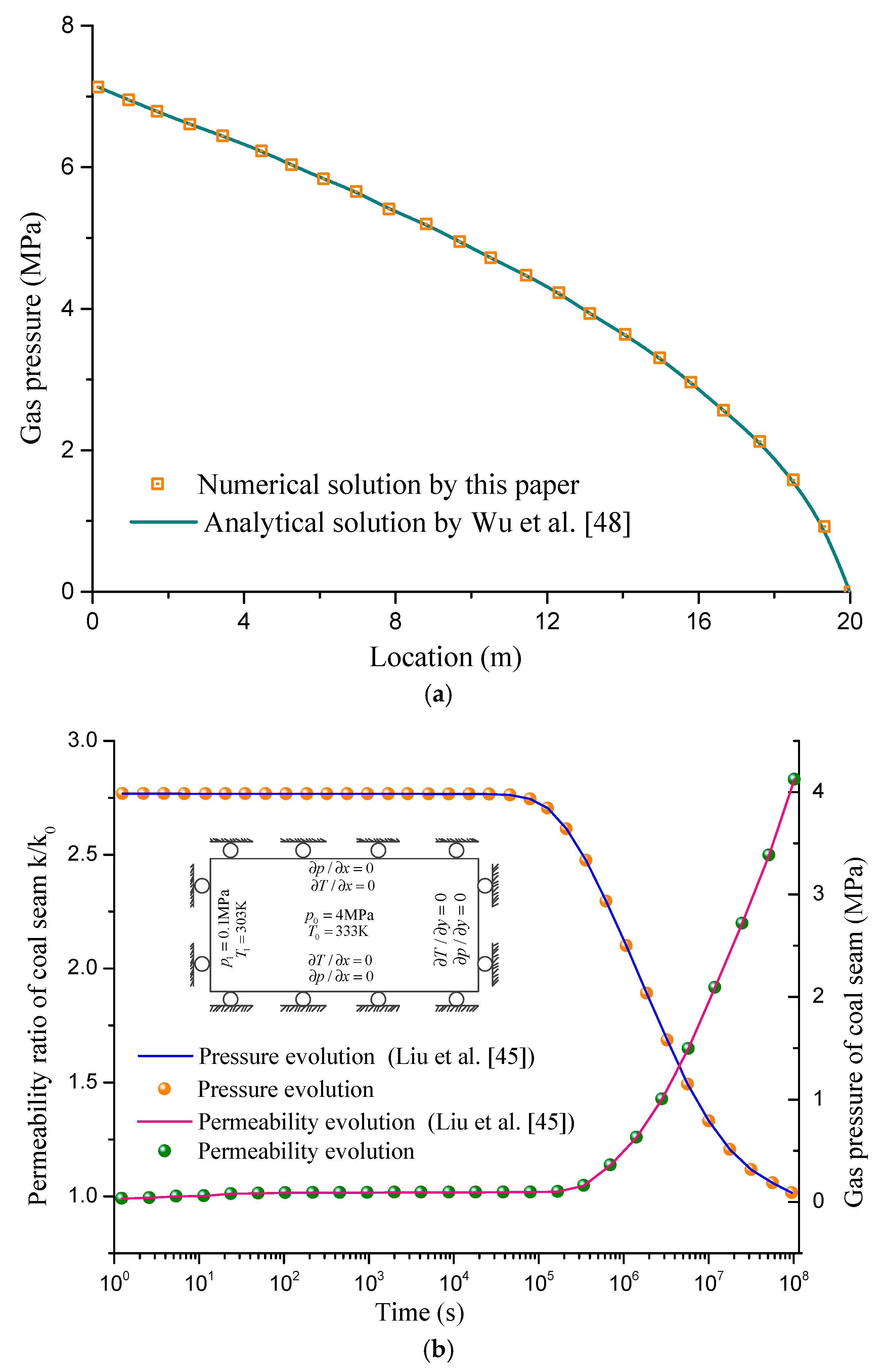

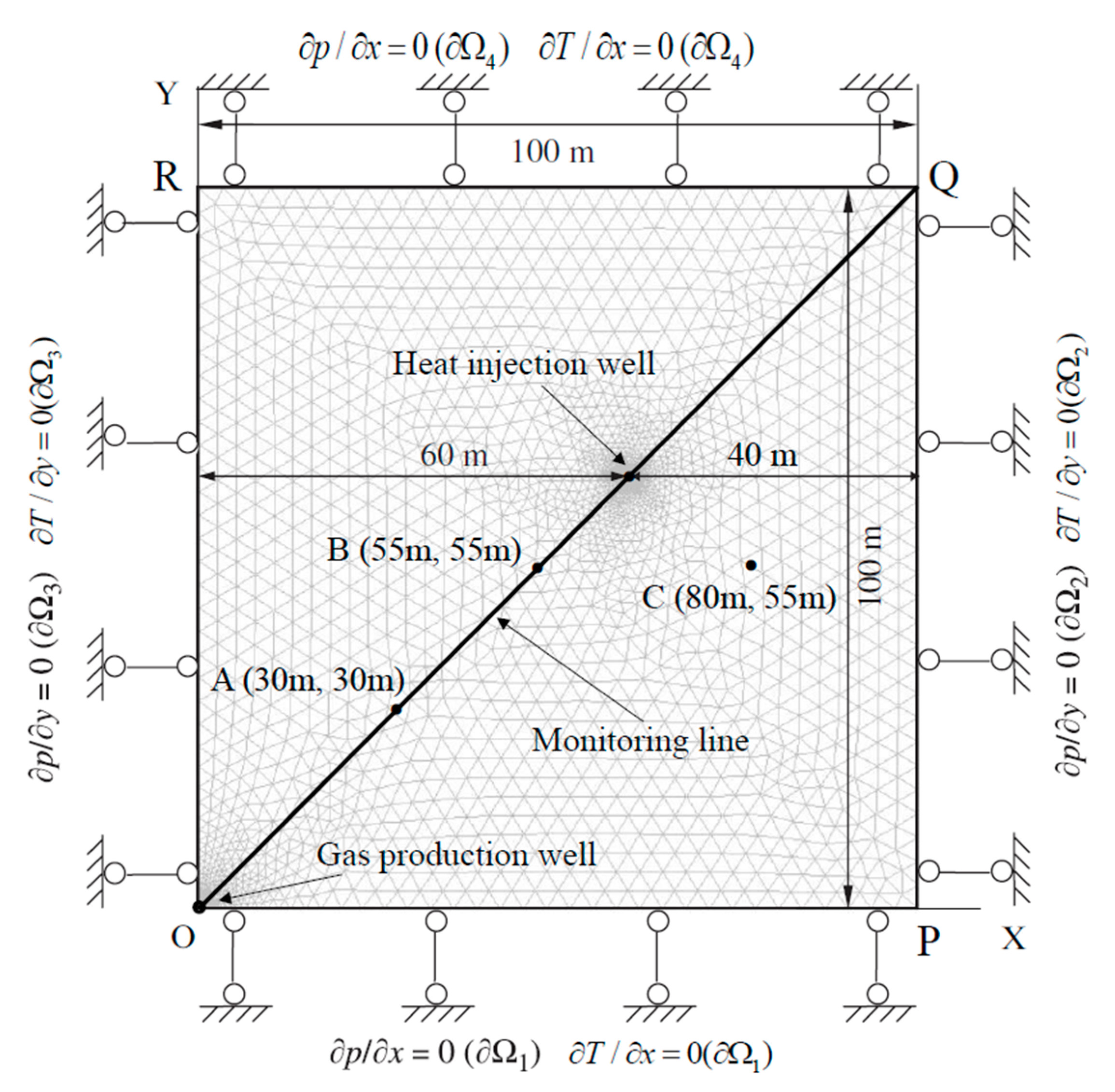

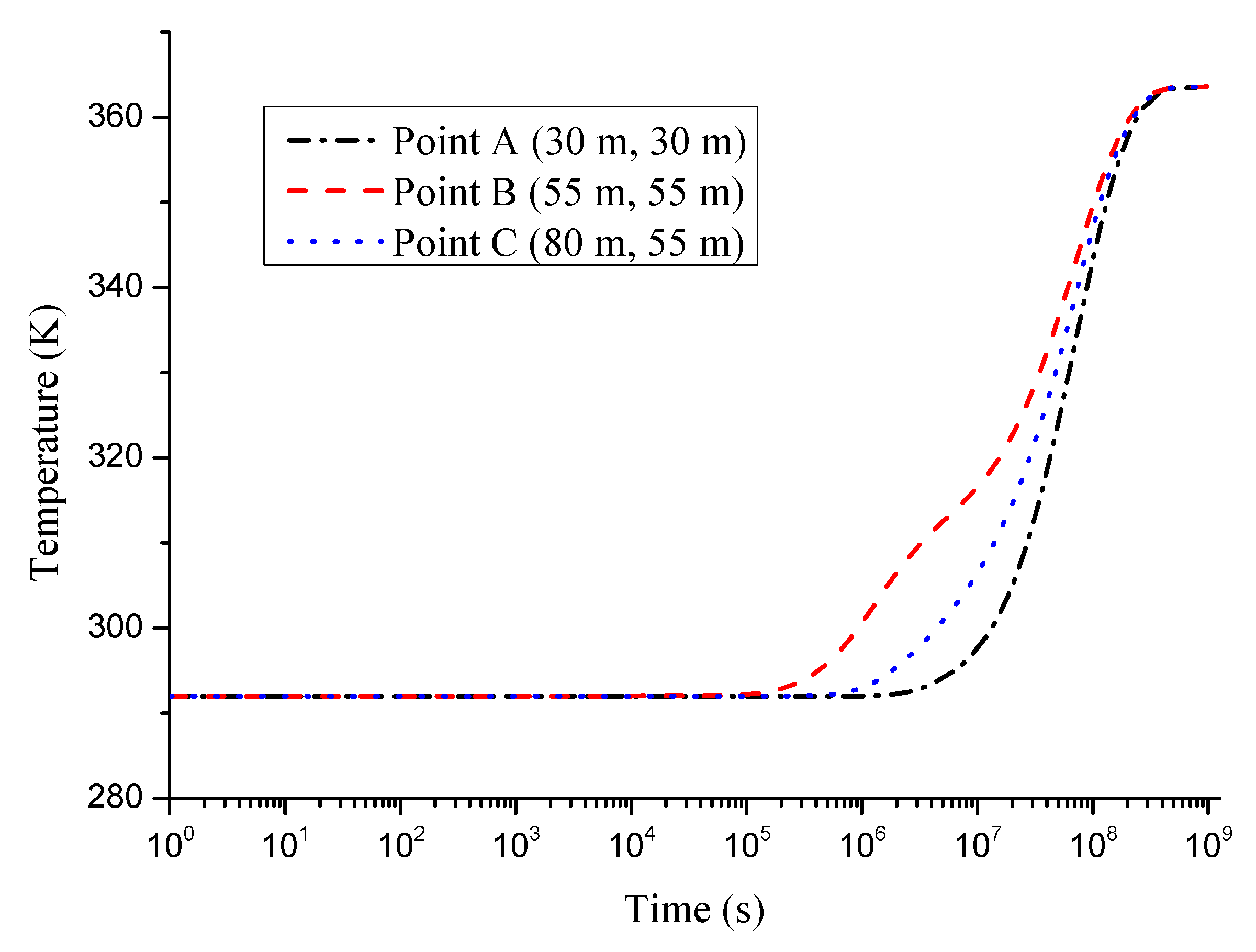


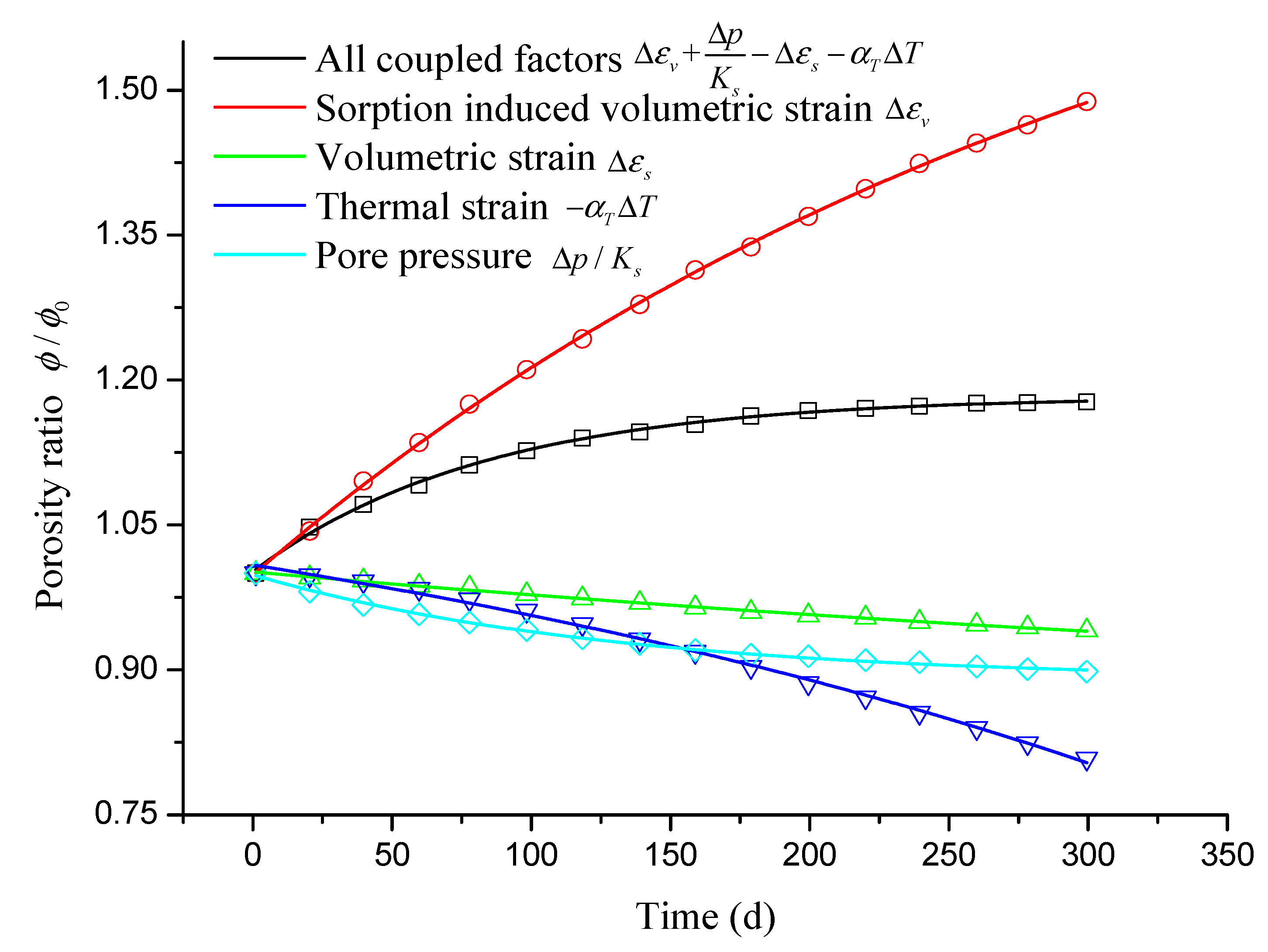
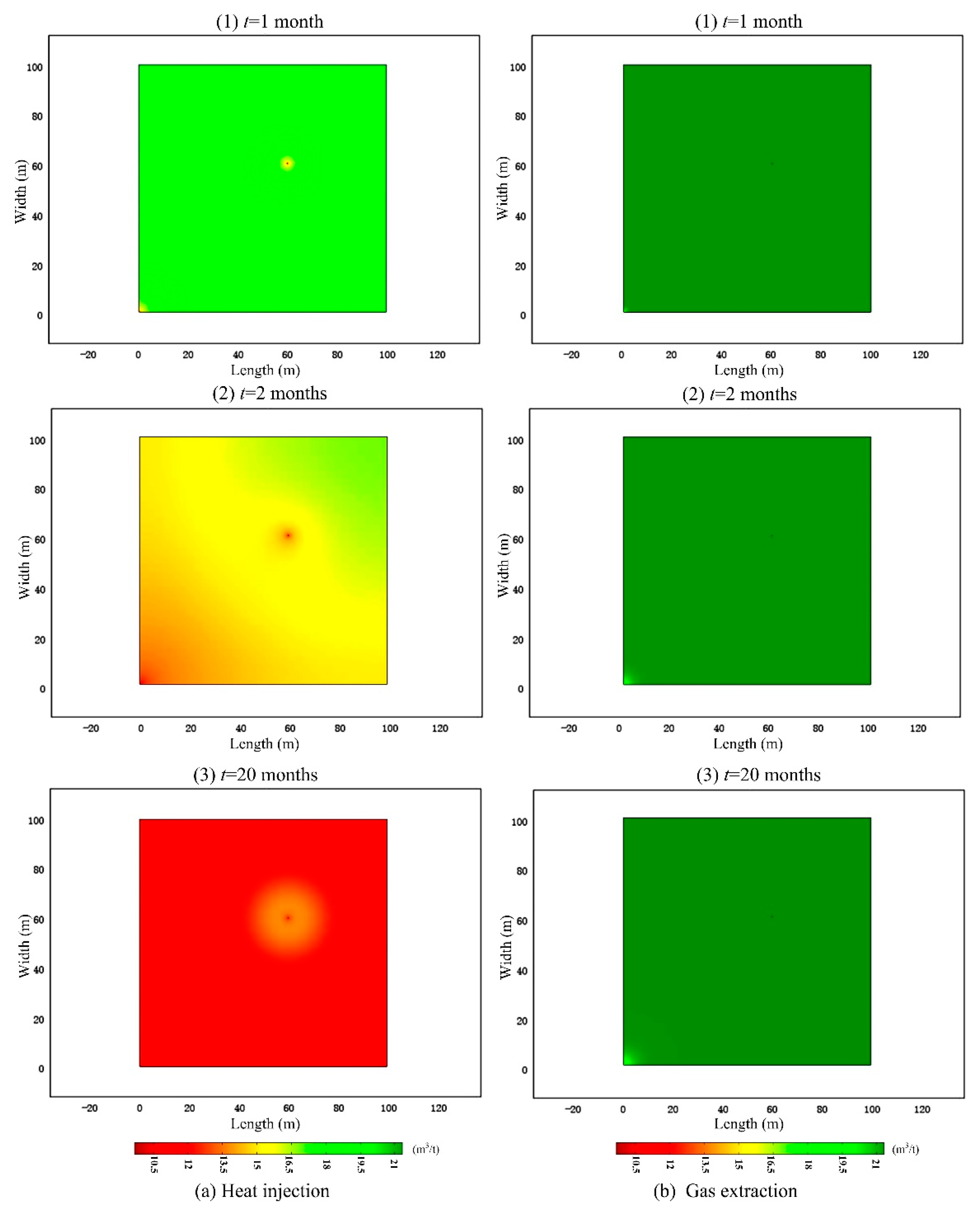


| Parameter | Value |
|---|---|
| Young’s modulus of coal (E, MPa) | 2700 |
| Young’s modulus of the coal grains (Es, MPa) | 7100 |
| Density of coal (, kg/m3) | 1380 |
| Poisson’s ratio of coal (, -) | 0.38 |
| Initial gas permeability (, m2) | 5.0 × 10−19 |
| Compressibility factor, (Mc/RT, kg/(Pa·m−3)) | 1.18 × 10−5 |
| Gas dynamic viscosity (, N·s/m2) | 1.84 × 10−5 |
| Length of the rock column (L, m) | 20 |
| Parameter | Value |
|---|---|
| Young’s modulus of coal (E, MPa) | 2700 |
| Young’s modulus of the coal grains (Es, MPa) | 7100 |
| Initial porosity (φ0, -) | 0.01 |
| Density of coal (ρc, kg/m3) | 1380 |
| Poisson’s ratio of coal (ν, -) | 0.38 |
| Initial gas permeability (k∞0, m2) | 1.09 × 10−18 |
| Density of CH4 at standard condition (ρg, kg/m3) | 0.717 |
| Gas dynamic viscosity (υ, N·s/m2) | 1.84 × 10−5 |
| CH4 Langmuir pressure constant (PL, MPa) | 1.57 |
| CH4 Langmuir volume constant (VL, m3/kg) | 0.043 |
| Specific heat capacity of gas (Cg, J/kg·K) | 1.005 × 103 |
| Specific heat capacity of coal (Cs, J/kg·K) | 1.25 × 103 |
| Pressure coefficient (c1, MPa−1) | 0.07 |
| Coefficient for sorption-induced volumetric strain (αsg, kg/m3) | 0.06 |
| Volumetric thermal expansion of the solid matrix coefficient (αT, K−1) | 2.4 × 10−5 |
| Klinkenberg effect (b, Pa) | 1.44 × 105 |
| Temperature coefficient (c2, MPa−1) | 0.02 |
| Thermal conductivity of coal (λs, J/m·s·K) | 0.2 |
| Field | Coal Deformation | Gas Flow | Heat Flow | |
|---|---|---|---|---|
| Initial value | Same as following | 3.0 MPa | 293 K | |
| Boundary value | OP | Normal displacement constraint | No flow | Thermal insulation |
| PQ | Normal displacement constraint | No flow | Thermal insulation | |
| QR | Normal displacement constraint | No flow | Thermal insulation | |
| RO | Normal displacement constraint | No flow | Thermal insulation | |
| Heat injection well | – | – | 362.4 K | |
| Gas production well | Free | 0.1 MPa | Thermal insulation | |
© 2018 by the authors. Licensee MDPI, Basel, Switzerland. This article is an open access article distributed under the terms and conditions of the Creative Commons Attribution (CC BY) license (http://creativecommons.org/licenses/by/4.0/).
Share and Cite
Xue, Y.; Dang, F.; Cao, Z.; Du, F.; Liu, F.; Ren, J.; Gao, F. Numerical Analysis of Heat and Gas Transfer Characteristics during Heat Injection Processes Based on a Thermo-Hydro-Mechanical Model. Energies 2018, 11, 1722. https://doi.org/10.3390/en11071722
Xue Y, Dang F, Cao Z, Du F, Liu F, Ren J, Gao F. Numerical Analysis of Heat and Gas Transfer Characteristics during Heat Injection Processes Based on a Thermo-Hydro-Mechanical Model. Energies. 2018; 11(7):1722. https://doi.org/10.3390/en11071722
Chicago/Turabian StyleXue, Yi, Faning Dang, Zhengzheng Cao, Feng Du, Fei Liu, Jie Ren, and Feng Gao. 2018. "Numerical Analysis of Heat and Gas Transfer Characteristics during Heat Injection Processes Based on a Thermo-Hydro-Mechanical Model" Energies 11, no. 7: 1722. https://doi.org/10.3390/en11071722




